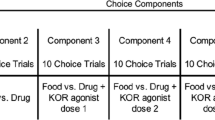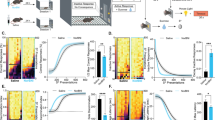Abstract
Rationale
The dynorphin (DYN)/kappa opioid receptor (KOR) system is involved in the dysphoric properties of drugs of abuse. Given that adolescents show reduced sensitivity to aversive effects of many drugs, alterations in the DYN/KOR system may contribute to the prevalence of drug use during adolescence.
Objectives
The present study was designed to assess dysphoric properties of a selective kappa agonist, U62,066, in adolescent and adult rats using both conditioned taste aversion (CTA) and conditioned place aversion (CPA) paradigms.
Methods
For CTA, water-restricted rats were administered U62,066 following 30 min access to a saccharin solution, with subsequent saccharin consumption used to index aversion. For CPA, animals were allowed access to both compartments of a two-compartment chamber for a 15-min pre- and post-conditioning test. For conditioning, subjects were administered U62,066 prior to confinement to one side of the chamber and saline prior to confinement to the other side for a total of four pairings.
Results
Overall, adolescents displayed reduced sensitivity to the kappa agonist relative to adults. Adults demonstrated taste aversions to the 0.2 and 0.3 mg/kg doses of U62,066, whereas adolescents did not display aversions to any tested doses. Adults demonstrated a place aversion to the 0.1 and 0.2 mg/kg dose of U62,066 when paired with the preferred side of the conditioning chamber. Adolescents did not display aversions to any of the doses tested.
Conclusions
Reduced sensitivity to DYN/KOR system activation during adolescence may be a contributing factor to the age-typical insensitivity to aversive properties of drugs commonly abused by adolescents.


Similar content being viewed by others
References
Adriani W, Laviola G (2003) Elevated levels of impulsivity and reduced place conditioning with d-amphetamine: two behavioral features of adolescence in mice. Behav Neurosci 117:695–703
Adriani W, Chiarotti F, Laviola G (1998) Elevated novelty seeking and peculiar d-amphetamine sensitization in periadolescent mice compared with adult mice. Behav Neurosci 112:1152–1166
Anderson RI, Varlinskaya EI, Spear LP (2010) Ethanol-induced conditioned taste aversion in male Sprague–Dawley rats: impact of age and stress. Alcohol Clin Exp Res 34:2106–2115
Anderson RI, Agoglia AE, Morales M, Varlinskaya EI, Spear LP (2013) Stress, kappa manipulations, and aversive effects of ethanol in adolescent and adult male rats. Neuroscience. doi:10.1016/j.neuroscience.2012.12.028
Badanich KA, Adler KJ, Kirstein CL (2006) Adolescents differ from adults in cocaine conditioned place preference and cocaine-induced dopamine in the nucleus accumbens septi. Eur J Pharmacol 550:95–106
Bals-Kubik R, Ableitner A, Herz A, Shippenberg T (1993) Neuroanatomical sites mediating the motivational effects of opioids as mapped by the conditioned place preference paradigm in rats. J Pharmacol Exp Ther 264:489–495
Bals-Kubik R, Herz A, Shippenberg TS (1989) Evidence that the aversive effects of opioid antagonists and kappa-agonists are centrally mediated. Psychopharmacology (Berlin) 98:203–206
Bardo MT, Rowlett JK, Harris MJ (1995) Conditioned place preference using opiate and stimulant drugs: a meta-analysis. Neurosci Biobehav Rev 19:39–51
Barr GA, Wang S, Carden S (1994) Aversive properties of the kappa opioid agonist U50,488 in the week-old rat pup. Psychopharmacology (Berlin) 113:422–428
Collins RL, Zavala AR, Nazarian A, McDougall SA (2000) kappa-Opioid receptors in the substantia nigra pars reticulata mediate the U-50,488-induced locomotor activity of preweanling rats. Brain Res Dev Brain Res 119:97–103
Cortez AM, Charntikov S, Der-Ghazarian T, Horn LR, Crawford CA, McDougall SA (2010) Age-dependent effects of kappa-opioid receptor stimulation on cocaine-induced stereotyped behaviors and dopamine overflow in the caudate-putamen: an in vivo microdialysis study. Neuroscience 169:203–213
Cunningham CL, Ferree NK, Howard MA (2003) Apparatus bias and place conditioning with ethanol in mice. Psychopharmacology (Berlin) 170:409–422
Doremus-Fitzwater TL, Varlinskaya EI, Spear LP (2010) Motivational systems in adolescence: possible implications for age differences in substance abuse and other risk-taking behaviors. Brain Cogn 72:114–123
Douglas LA, Varlinskaya EI, Spear LP (2003) Novel-object place conditioning in adolescent and adult male and female rats: effects of social isolation. Physiol Behav 80:317–325
Hartup WW, Stevens N (1997) Friendships and adaptation in the life course. Psychol Bull 121:355–370
Holson RR, Pearce B (1992) Principles and pitfalls in the analysis of prenatal treatment effects in multiparous species. Neurotoxicol Teratol 14:221–228
Hurwitz ZE, Merluzzi AP, Riley AL (2012) Age-dependent differences in morphine-induced taste aversions. Dev Psychobiol. doi:10.1002/dev.21046
Infurna RN, Spear LP (1979) Developmental changes in amphetamine-induced taste aversions. Pharmacol Biochem Behav 11:31–35
Iwamoto EI (1986) Place-conditioning properties of mu, kappa, and sigma opioid agonists. Alcohol Drugs Res 6:327–339
Johnston LD, O’Malley PM, Bachman JG, Schulenberg JE (2012) Monitoring the Future national results on adolescent drug use: overview of key findings, 2011. Institute for Social Research, The University of Michigan, Ann Arbor
Kelley AE, Schochet T, Landry CF (2004) Risk taking and novelty seeking in adolescence: introduction to part I. Ann N Y Acad Sci 1021:27–32
Laviola G, Macri S, Morley-Fletcher S, Adriani W (2003) Risk-taking behavior in adolescent mice: psychobiological determinants and early epigenetic influence. Neurosci Biobehav Rev 27:19–31
Logrip ML, Janak PH, Ron D (2009) Blockade of ethanol reward by the kappa opioid receptor agonist U50,488H. Alcohol 43:359–365
McDougall SA, Garmsen GM, Meier TL, Crawford CA (1997) Kappa opioid mediated locomotor activity in the preweanling rat: role of pre- and postsynaptic dopamine receptors. Psychopharmacology (Berlin) 133:62–68
McLaughlin JP, Land BB, Li S, Pintar JE, Chavkin C (2006) Prior activation of kappa opioid receptors by U50,488 mimics repeated forced swim stress to potentiate cocaine place preference conditioning. Neuropsychopharmacology 31:787–794
Michaels CC, Holtzman SG (2008) Early postnatal stress alters place conditioning to both mu- and kappa-opioid agonists. J Pharmacol Exp Ther 325:313–318
Morales L, Perez-Garcia C, Herradon G, Alguacil LF (2007) Place conditioning in a two- or three-conditioning compartment apparatus: a comparative study with morphine and U-50,488. Addict Biol 12:482–484
Mucha RF, Herz A (1985) Motivational properties of kappa and mu opioid receptor agonists studied with place and taste preference conditioning. Psychopharmacology (Berlin) 86:274–280
Nizhnikov ME, Pautassi RM, Varlinskaya EI, Rahmani P, Spear NE (2012) Ontogenetic differences in ethanol's motivational properties during infancy. Alcohol 46:225–234
Petrov ES, Nizhnikov ME, Varlinskaya EI, Spear NE (2006) Dynorphin A (1-13) and responsiveness of the newborn rat to a surrogate nipple: immediate behavioral consequences and reinforcement effects in conditioning. Behav Brain Res 170:1–14
Primus RJ, Kellogg CK (1989) Pubertal-related changes influence the development of environment-related social interaction in the male rat. Dev Psychobiol 22:633–643
Roma PG, Riley AL (2005) Apparatus bias and the use of light and texture in place conditioning. Pharmacol Biochem Behav 82:163–169
Sante AB, Nobre MJ, Brandao ML (2000) Place aversion induced by blockade of mu or activation of kappa opioid receptors in the dorsal periaqueductal gray matter. Behav Pharmacol 11:583–589
Schramm-Sapyta NL, Morris RW, Kuhn CM (2006) Adolescent rats are protected from the conditioned aversive properties of cocaine and lithium chloride. Pharmacol Biochem Behav 84:344–352
Schramm-Sapyta NL, Cha YM, Chaudhry S, Wilson WA, Swartzwelder HS, Kuhn CM (2007) Differential anxiogenic, aversive, and locomotor effects of THC in adolescent and adult rats. Psychopharmacology (Berlin) 191:867–877
Shippenberg TS, Herz A (1986) Differential effects of mu and kappa opioid systems on motivational processes. NIDA Res Monogr 75:563–566
Shippenberg TS, Zapata A, Chefer VI (2007) Dynorphin and the pathophysiology of drug addiction. Pharmacol Ther 116:306–321
Shram MJ, Funk D, Li Z, Le AD (2006) Periadolescent and adult rats respond differently in tests measuring the rewarding and aversive effects of nicotine. Psychopharmacology 186:201–208
Spear LP (2000) The adolescent brain and age-related behavioral manifestations. Neurosci Biobehav Rev 24:417–463
Spear LP (2010) The behavioral neuroscience of adolescence. Norton, New York
Spear LP (2011) Rewards, aversions and affect in adolescence: emerging convergences across laboratory animal and human data. Dev Cogn Neurosci 1:390–403
Steinberg L (2008) A social neuroscience perspective on adolescent risk-taking. Dev Rev 28:78–106
Tejeda HA, Natividad LA, Orfila JE, Torres OV, O'Dell LE (2012) Dysregulation of kappa-opioid receptor systems by chronic nicotine modulate the nicotine withdrawal syndrome in an age-dependent manner. Psychopharmacology (Berl) 224:289–301
Torres OV, Tejeda HA, Natividad LA, O'Dell LE (2008) Enhanced vulnerability to the rewarding effects of nicotine during the adolescent period of development. Pharmacol Biochem Behav 90:658–663
Tzschentke TM (1998) Measuring reward with the conditioned place preference paradigm: a comprehensive review of drug effects, recent progress and new issues. Prog Neurobiol 56:613–672
Tzschentke TM (2007) Measuring reward with the conditioned place preference (CPP) paradigm: update of the last decade. Addict Biol 12:227–462
Varlinskaya EI, Spear LP (2008) Social interactions in adolescent and adult Sprague–Dawley rats: impact of social deprivation and test context familiarity. Behav Brain Res 188:398–405
Vastola BJ, Douglas LA, Varlinskaya EI, Spear LP (2002) Nicotine-induced conditioned place preference in adolescent and adult rats. Physiol Behav 77:107–114
Vetter-O'Hagen CS, Spear LP (2012) Hormonal and physical markers of puberty and their relationship to adolescent-typical novelty-directed behavior. Dev Psychobiol 54:523–535
Vetter-O'Hagen C, Varlinskaya E, Spear L (2009) Sex differences in ethanol intake and sensitivity to aversive effects during adolescence and adulthood. Alcohol Alcohol 44:547–554
Wadenberg ML (2003) A review of the properties of spiradoline: a potent and selective kappa-opioid receptor agonist. CNS Drug Rev 9:187–198
Wee S, Koob GF (2010) The role of the dynorphin-kappa opioid system in the reinforcing effects of drugs of abuse. Psychopharmacology (Berl) 210:121–135
Wilmouth CE, Spear LP (2004) Adolescent and adult rats’ aversion to flavors previously paired with nicotine. Ann N Y Acad Sci 1021:462–464
Zakharova E, Leoni G, Kichko I, Izenwasser S (2009a) Differential effects of methamphetamine and cocaine on conditioned place preference and locomotor activity in adult and adolescent male rats. Behav Brain Res 198:45–50
Zakharova E, Wade D, Izenwasser S (2009b) Sensitivity to cocaine conditioned reward depends on sex and age. Pharmacol Biochem Behav 92:131–134
Zhang Y, Butelman ER, Schlussman SD, Ho A, Kreek MJ (2005) Effects of the plant-derived hallucinogen salvinorin A on basal dopamine levels in the caudate putamen and in a conditioned place aversion assay in mice: agonist actions at kappa opioid receptors. Psychopharmacology (Berlin) 179:551–558
Zorrilla EP (1997) Multiparous species present problems (and possibilities) to developmentalists. Dev Psychobiol 30:141–150
Conflict of interest
The authors have no conflicts of interest to disclose.
Author information
Authors and Affiliations
Corresponding author
Additional information
The work presented in this manuscript was funded by grants AA017823 to LPS and AA012453 to EIV.
Rights and permissions
About this article
Cite this article
Anderson, R.I., Morales, M., Spear, L.P. et al. Pharmacological activation of kappa opioid receptors: aversive effects in adolescent and adult male rats. Psychopharmacology 231, 1687–1693 (2014). https://doi.org/10.1007/s00213-013-3095-8
Received:
Accepted:
Published:
Issue Date:
DOI: https://doi.org/10.1007/s00213-013-3095-8




